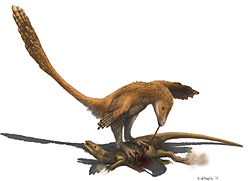Zephyrosaurus
|
Zephyrosaurus Temporal range: Early Cretaceous, Aptian–Albian |
|
|---|---|
 |
|
| Restoration of Zephyrosaurus being attacked by a Deinonychus | |
| Scientific classification | |
| Kingdom: | Animalia |
| Phylum: | Chordata |
| Class: | Reptilia |
| Clade: | Dinosauria |
| Order: | †Ornithischia |
| Family: | †Thescelosauridae |
| Subfamily: | †Orodrominae |
| Genus: |
†Zephyrosaurus Sues, 1980 |
| Type species | |
|
†Zephyrosaurus schaffi Sues, 1980 |
|
Zephyrosaurus (meaning "westward wind lizard") is a valid genus of orodromin ornithopod dinosaur. It is based on a partial skull and postcranial fragments discovered in the Aptian-Albian-age Lower Cretaceous Cloverly Formation of Carbon County, Montana, USA. New remains are under description, and tracks from Maryland and Virginia, also in the USA, have been attributed to animals similar to Zephyrosarus.
Zephyrosaurus is still very incompletely known. Among other distinctive characteristics, it had a steep face, a raised knob on the upper jaw, and a larger knob on the cheekbone. Some of the bones may have allowed movement within the skull (cranial kinesis) as well. Like other orodromins, it had beak teeth.
Several studies have suggested that Zephyrosaurus and Orodromeus are closely related, mostly by virtue of both having bosses (described informally as "somewhat like an altoid") on their cheeks. Other studies have had difficulty classifying it, due to the sparseness of the original material.Oryctodromeus also shares several characteristics with Zephyrosaurus and Orodromeus, some of which may be related to burrowing. Phylogenetic analysis in the 2010s has classified Zephyrosaurus as part of the Thescelosauridae family.
Hans-Dieter Sues named his new genus in recognition of the fossil being found in western North America, and Charles R. Schaff, who found the specimen. MCZ 4392, the type specimen, is composed of jaw fragments, the braincase and associated bones, several partial vertebrae, and rib fragments. He found the new genus to represent a previously unknown lineage of hypsilophodont (a taxon now considered not natural), similar in some respects to Hypsilophodon.
...
Wikipedia
